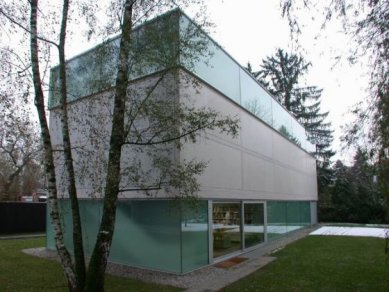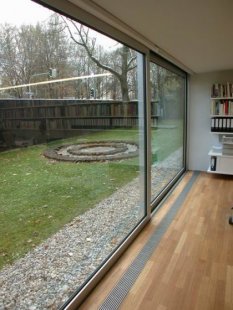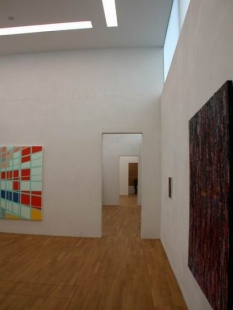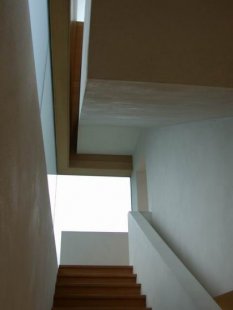
Gallery Goetz

To the problem where the museum's architecture competes with the exhibited exhibits, someone is constantly commenting. Whether it is due to the overabundance of shapes or its austerity. Painter Helmut Federle has expressed his dissatisfaction with the state of the current existing exhibition spaces several times. Together with Jacques Herzog and Pierre de Meuron, he created a spatial concept for the Goetz collection and formulated his troubles into a petition:
"... I consider these prestigious buildings (museums), which are emerging everywhere, to be fundamentally flawed. First of all, it is an ideological problem. The building itself is regarded as an admired cult object in which art is degraded to a supplementary function. Ideally, it will compete, leaving the demonstration of power to architecture, because architecture wants to be an image itself."
"Museums attempt to be more artistic than the art within them."
The gallery is a free-standing volume situated within a park-like garden of birches and conifers and between the street and the house from the 1960s. Thus the building can be used both as a public as well as a purely private gallery; a rule that is to be settled in the future. The building's architectural conception corresponds to the character of the works that the collector has brought together over the last 30 years, embracing the art of the 1960s to today: Nauman, Ryman, Koune- liis, Federle, Rückriem and others.
A timber configuration rests on a reinforced-concrete base of the same dimension, that is half buried so that only its upper glazed perimeter is visible from the outside. A similar matte glass strip surrounds the timber volume at the uppermost section, admitting diffuse glare-free daylight from a height of four meters into the exhibition spaces. The walls within the exhibition spaces are between four to five and a half meters high. Two reinforced-concrete tubes are set laterally between the lower and upper galleries. The larger of the two serves as the office and reception. Depending on the daylight conditions and the point of view of the observer, the gallery appears either as a closed, flush volume consisting of related materials (birch plywood, matte glass, untreated aluminum) or as a wooden box that, resting on two trowels, has come to rest in the garden.
"... I consider these prestigious buildings (museums), which are emerging everywhere, to be fundamentally flawed. First of all, it is an ideological problem. The building itself is regarded as an admired cult object in which art is degraded to a supplementary function. Ideally, it will compete, leaving the demonstration of power to architecture, because architecture wants to be an image itself."
H.Federle, Werk, Bauen und Wohnen, No.1/2 1994
"Museums attempt to be more artistic than the art within them."
Markus Lüpertz, Kunst und Architektur, Frankfurt 1985
The gallery is a free-standing volume situated within a park-like garden of birches and conifers and between the street and the house from the 1960s. Thus the building can be used both as a public as well as a purely private gallery; a rule that is to be settled in the future. The building's architectural conception corresponds to the character of the works that the collector has brought together over the last 30 years, embracing the art of the 1960s to today: Nauman, Ryman, Koune- liis, Federle, Rückriem and others.
A timber configuration rests on a reinforced-concrete base of the same dimension, that is half buried so that only its upper glazed perimeter is visible from the outside. A similar matte glass strip surrounds the timber volume at the uppermost section, admitting diffuse glare-free daylight from a height of four meters into the exhibition spaces. The walls within the exhibition spaces are between four to five and a half meters high. Two reinforced-concrete tubes are set laterally between the lower and upper galleries. The larger of the two serves as the office and reception. Depending on the daylight conditions and the point of view of the observer, the gallery appears either as a closed, flush volume consisting of related materials (birch plywood, matte glass, untreated aluminum) or as a wooden box that, resting on two trowels, has come to rest in the garden.
The English translation is powered by AI tool. Switch to Czech to view the original text source.
0 comments
add comment



















